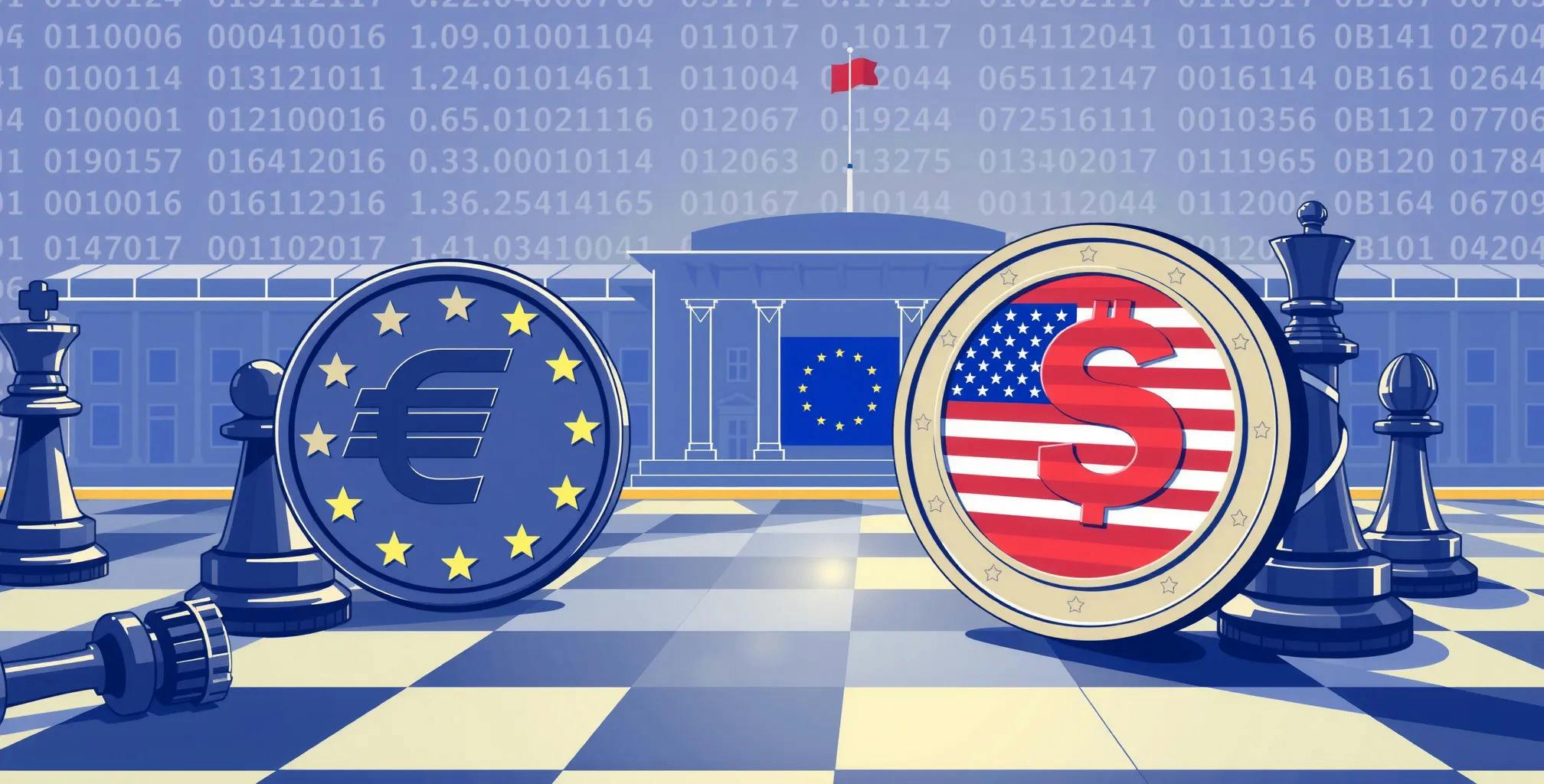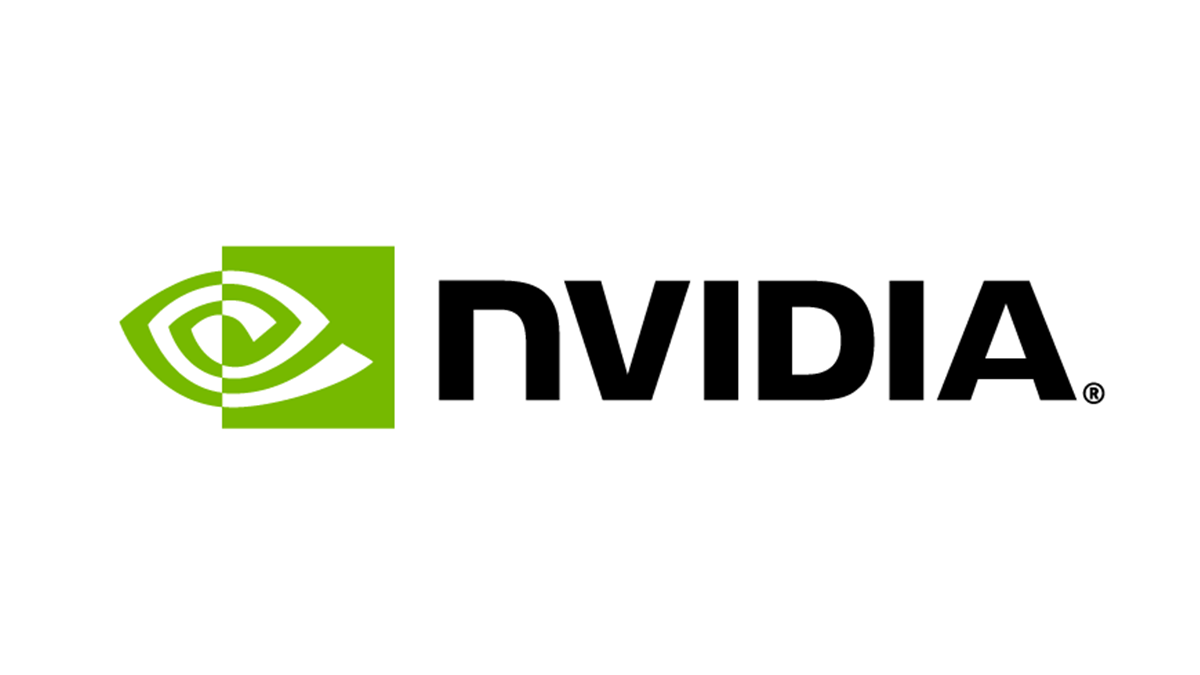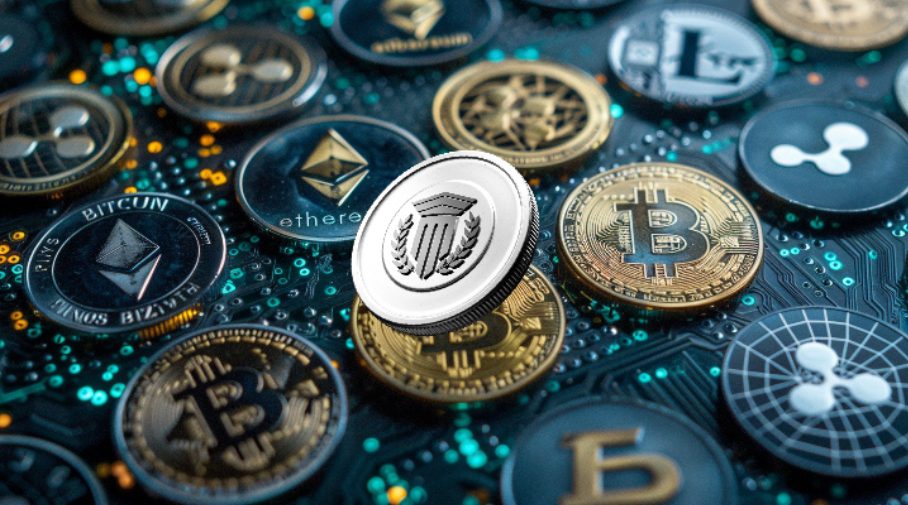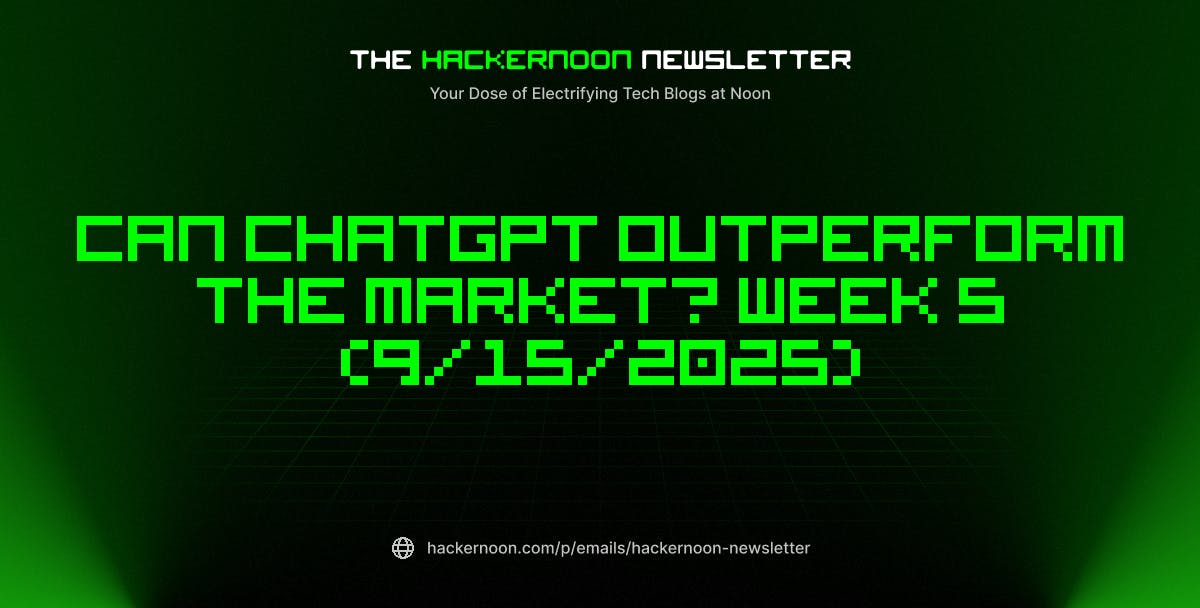The White House has declared “Crypto Week”, a push to lead to clarity for cryptocurrencies and digital assets. The industry is eagerly waiting for three different bills, the “CLARITY Act” [1]*, the “GENIUS Act”[2]*, and the “Anti-CBDC Surveillance State Act”[3] to pass this week and is hoping for a positive impact on the sector. The bill’s language and framing are already pretty clear: Stablecoins are favored and should be supported, while CBDCs (Central Bank Digital Currencies) experimentation by the FED (Federal Reserve) should be abandoned and forgotten.
The stance of the US, or more precisely of President Trump and his advisors, is clear and the opposite of what is happening in the European Union. This might lead to further divergence of the American and European point of view and could create a potential dilemma for the ECB (European Central Bank).
US Policy Flip — From Scrutiny to Support?
Under the Biden administration and the SEC Chair Gary Gensler, cryptocurrencies as well as stablecoins were scrutinized. Regulators argued that they threaten the US Dollar as they could be used as a means of payment without relying on FED-issued US Dollars. The fear is clear: the FED would have less influence on their monetary policies as people could circumvent them by using “private money”.
Under the Trump administration, the view on cryptocurrencies and especially stablecoins changed a lot. They are seen favorably and as a new and developing industry branch on which the US could position itself strategically as a leader. The timing of this change of heart couldn’t have been more perfect. At the same time, in Europe MiCA [4] *, the first regulation on cryptocurrencies, came into force and heavily restricted companies in this sector.
With no real regulation in place in the US besides an occasional Howey test [5] to make sure cryptos are not securities (infamous Ripple XRP lawsuit [6]), the US was still the “Wild West”. Therefore, they welcomed crypto-companies moving from Europe to the United States that are fleeing regulation. Part of the shift of the stance also seems to be more strategic and based on how currency-pegged stablecoins work.
Stablecoins — Now a Top Buyer of US Debt
US currency-backed stablecoins, like Circle’s USDC, maintain their $1-peg by always keeping a 1:1 reserve of US Dollars … or near-cash equivalents. Particularly, these near-cash equivalents are of interest in the finance industry, like US Treasury Debt and Repurchase Agreements. The advantage is that they pay a yield, and yet they are highly liquid. Circle can therefore convert its USDC back to US Dollars in a matter of hours. Most of Circle’s reserves are therefore Treasuries, as they tokenize them, keep the yield, and issue stablecoins. That’s the core of their business model.
Circle is a prime example as they are transparent about their reserve. They have $62.7 billion USDC in circulation and a reserve that is composed of $9.2 billion cash at reserve banks and $53.7 billion in the Circle Reserve Fund as of May 2025 [7]. This reserve fund holds 62.02% US Treasury Repurchase Agreements and 27.98% US Treasury Debt [8].
Circle is the second-biggest stablecoin issuer behind Tether, which boasts a market capitalization on their USDT of nearly $160 billion by July 2025. Tether remains opaque, or in other words, is just bluntly untransparent about its reserve. It is known, however, that combined, Circle and Tether are the 18th-largest holders of US debt, behind South Korea and before Germany [9]. In the year 2024, Tether was even the 7th largest buyer of US treasuries behind the UK and Singapore [9].
Both companies were able to boast huge profits with this business model: $155 million for Circle and even $13 billion for Tether [10].
Stablecoins and US debt — a Win-Win
Obviously, with the size that Circle and Tether have reached, they play a significant role in the treasury market. Their treasury purchases help finance the US national debt, which supports liquidity and the stability of the Treasury Market. A stablecoin regulation, like the “GENIUS Act” [2], could assure that both of these companies remain fully operational, mitigate any risk to the treasury market, and assure further demand in the future. This, in turn, helps these companies to further develop and ensures that the supply of stablecoins grows steadily. Thereby reinforcing that tokenized assets as well as crypto-assets would be exchanged against dollars, making it a dollarized market. The dominance of the US dollar as well as its status as primary reserve would remain protected this way.
The Other Side of the (Stable)Coin
Yet the size that both Circle and Tether have attained makes regulation more than overdue. They could pose a systemic risk as they hold a significant amount of US Treasury debt. A case of financial difficulties or a loss of confidence could lead to a rapid sell-off, potentially destabilizing the treasury market. In the case of Tether, even more issues could face the day as they are untransparent about the composition of their reserve, but this is not the subject of this article.
Monetary Policy is the second and the more important risk factor. This certainly has been the main concern about stablecoins under the Biden administration and why they were scrutinized so much. The widespread use of stablecoins could hinder the potential implementations and effectiveness of monetary policies that are decided by the FED.
FED versus Trump — CBDC versus stablecoin
The FED fears that its transmission mechanisms for economic policies might be hindered due to the use of stablecoins. As they have no control over stablecoins, they might have no control over their policy leavers. If a significant portion of transactions or savings are in stablecoins, the traditional mechanisms through which the FED influences economic activity become less effective. Both rate changes and controlling the monetary supply would become more difficult. The demand for traditional bank deposits may decrease, which reduces the amount of money that the banks lend out. This could have widespread implications and could potentially force central banks to rethink how economic interference must or can be conducted in the future.Hence why the FED generally opposes the usage of stablecoins and favors its CBDCs, a dollar on the blockchain, but with the difference that the FED issues and programs it instead of private companies. With the ongoing Anti-CBDC bill this week, Trump wants to oppose the usage of a CBDC and restrain the FED’s experimentation in favor of stablecoins, which continue to buy up the debt of the United States at a fast pace.
But what about Europe?
Europe, however, is in a very different position compared to the United States. The doctrine could not be more opposite to Trump’s, so here it is more likely to be a “regulation first, then perhaps loosen the screws to support innovation”-approach if you want. This is more conservative, but safer, as we can see from the FED’s own position.
MiCA regulation — Stablecoins are okay, if regulated
MiCA covers the topic of stablecoins and defines two different categories of them.
Electronic Money Tokens [4]:
EMTs are crypto-assets that aim to maintain a stable value by referencing the value of a single currency. Their primary activity is payments, and the issuer of EMTs must obtain authorizations as an Electronic Money Institution (EMI) or Credit Institution in the EU. This means that they must comply with financial standards and regulatory requirements. This implies, obviously, the maintenance of a 1:1 reserve of the issued stablecoins of highly liquid and low-risk assets. Additionally, the asset reserve must be audited at least every 6 months.
Asset-Referenced Tokens [4]:
ARTs are crypto-assets that aim to maintain a stable value by referencing multiple currencies that are legal tender, or one or multiple commodities, or also other cryptocurrencies, or even a basket of all of them. ARTs issuers must be authorized, supervised by regulatory authorities, and based in the EU. ARTs issuers must also ensure an adequate reserve to back the issuance of the stablecoin.
This led to Circle taking over the European Market as they complied with MiCA, in contrast to Tether, who left the European Market because they did not want to comply and wanted to “focus on other markets” [11].
Circle‘s Near-Monopoly in Europe — so EURC or USDC?
The short answer is: USDC. The dominance of US dollar denomination in the cryptocurrency industry is so prevalent Europeans also trade mostly USDC. Circle’s euro-pegged stablecoin, called EURC, has a market capitalization of only a bit more than $200 million [12]. To put that into perspective — this means that the market capitalization of USDC is more than 290 times larger than the market capitalization of EURC.
But how come? First off and the simplest explanation is the first mover advantage of US dollar-denominated stablecoins. USDT and later USDC were the first ones to exist in the cryptocurrency industry, which naturally set the unit for account, leading to a digital dollarization of the industry. Due to their heavy utilization as counterparty of many trade pairs and their huge market capitalization, they benefit from greater liquidity and greater market depth.
Secondly, Europe explored the subject of CBDCs relatively early instead of stablecoins.
The Euro-CBDC — a costly gamble
The ECB began its Euro-CBDC project in Oct 2020. They rolled out an extensive program ranging from first investigation phases to current preparation phases. Even though not many details are public, it is known that it is a collaboration with several central banks outside the euro area. Unofficial estimates put the budget near €1.7 billion. The goal of the CBDC is clear and straightforward: Not lose sovereignty of means of payments to stablecoins. So, the ECB is in a very similar position to the FED, where payments on blockchains are generally seen as innovative and the future, but not in the form of “private money”, but in the form of a CBDC that a central bank can control.
The dilemma: US stablecoin versus Euro-CBDC
Ultimately, the BCE faces a major dilemma in Europe. After much effort, the development of a CBDC could still be abandoned and shelved or, even worse, be released but never catch on [13][14]. The advantages of a CBDC are obvious for the BCE, as their stance is similar to that of the FED. No central bank wants to hand over its authority to stablecoin issuers, potentially give up on its economic tools, and lose sovereignty. Should a CBDC fail while stablecoins continue to take over the market, the EU would have to work on a contingency plan. A plan that allows euro stablecoins to gain ground in the European market to not lose to the digital dollarization.
If this is not the case and stablecoins continue their current parabolic rise, the ECB risks losing the upper hand with the euro as the primary means of payment. The implications that the Fed is concerned about could hit the ECB even harder. The Fed’s interventions on the market may have a weakened or indirect influence through the stablecoin issuers. But the ECB’s tools would no longer have any influence at all in a dollarized digital market. This would leave the European digital market completely exposed and hard to govern directly. Not only that, but the American market and the European market are in very different conditions and require very different interventions. While there still have been no interest cuts lately in the US and the FED Funds Interest Rate is still at 4,5% [15], the interest rate in the EU has already been cut several times and sits currently at 2,15% [16].
In addition, the ECB is indispensable for the European market and for the existence of the EU. The euro area, consisting of 20 countries, requires much more nuanced financial interventions in order to be able to respond to the needs of the individual euro area countries.
Conclusion
So what now for Europe and the ECB? Either the ECB puts all its eggs in one basket and continues to pursue the CBDC and imposes it on its citizens in order to retain sovereignty. Thereby, they run the risk of the CBDC flopping and being rejected. Or the ECB starts promoting Euro-stablecoins so that they can rival US-stablecoins on the European market and possibly manage to regain market share. However, this second option also requires the ECB to give up power and some of its economic tools, as the viability of them will only be enforced to a lesser extent and indirectly through stablecoin issuers.
A combination of imposing a CBDC and promoting euro stablecoins at the same time hardly seems like a very valid option, because inevitably, one of the options will cannibalize the other. This could also lead to the ECB losing power, be it with the CBDC or a stablecoin.
What the ECB strategically does is within its own power and will certainly also depend on the outcome of votes on the bills in the White House. Either way, stablecoins have been on a very strong rise for more than a year now and are being embraced by the private sector.
Europe is in a sticky situation and should urgently decide. Either they consider a CBDC to be worth further pursuing, or to support euro-denominated stablecoins. The time is ticking before the digital dollarization becomes irreversible.
Appendix/Vocabulary
“CLARITY Act” — Digital Asset Market Clarity Act
“GENIUS Act” — Guiding and Establishing National Innovation for U.S. Stablecoins Act
MiCA — Markets in Crypto Assets
References:
[1] Paul Tierno, “Crypto Legislation: An Overview of H.R. 3633, the CLARITY Act.” Accessed: Jul. 15, 2025. [Online]. Available: https://www.congress.gov/crs-product/IN12583
[2] B. [R-T. Sen. Hagerty, “Text — S.394–119th Congress (2025–2026): GENIUS Act of 2025.” Accessed: Jul. 15, 2025. [Online]. Available: https://www.congress.gov/bill/119th-congress/senate-bill/394/text/is
[3] Committee on Financial Services to accompany H.R. 1919, “H.R. 1919 — Anti-CBDC Surveillance State Act | House of Representatives Committee on Rules.” Accessed: Jul. 15, 2025. [Online]. Available: https://rules.house.gov/bill/119/hr-1919
[4] European Parliament and Council, “Regulation (EU) 2023/1114 of the European Parliament and of the Council of 31 May 2023 on markets in crypto-assets, and amending Regulations (EU) No 1093/2010 and (EU) No 1095/2010 and Directives 2013/36/EU and (EU) 2019/1937,” May 2023.
[5] N. Reiff, “Howey Test Definition: What It Means and Implications for Cryptocurrency,” Investopedia. Accessed: Jul. 15, 2025. [Online]. Available: https://www.investopedia.com/terms/h/howey-test.asp
[6] A. B. AK Qadir, “Ripple vs SEC: CEO Celebrates XRP Lawsuit Win, But Here’s Why It’s Not Fully Over Yet,” Coinpedia Fintech News. Accessed: Jul. 15, 2025. [Online]. Available: https://coinpedia.org/news/ripple-vs-sec-ceo-celebrates-xrp-lawsuit-win-but-heres-why-its-not-fully-over-yet/
[7] Circle, “Transparency & Stability — Circle.” Accessed: Jul. 15, 2025. [Online]. Available: https://www.circle.com/transparency
[8] BlackRock, “Circle Reserve Fund | USDXX | Institutional,” BlackRock. Accessed: Jul. 15, 2025. [Online]. Available: https://www.blackrock.com/cash/en-us/products/329365/circle-reserve-fund
[9] L. Valente, “Stablecoins Could Become One Of The US Government’s Most Resilient Financial Allies,” Ark Invest. Accessed: Jul. 15, 2025. [Online]. Available: https://www.ark-invest.com/articles/analyst-research/stablecoins-as-a-us-financial-ally
[10] The Big Whale, “Bénéfices 2024 : Banque vs Stablecoins.” Accessed: Jul. 15, 2025. [Online]. Available: https://www.thebigwhale.io/charts/benefices-2024-banque-vs-stablecoins
[11] B. Peak, “Why Tether refuses to comply with MiCA — A Deep Dive,” Cointelegraph. Accessed: Jul. 15, 2025. [Online]. Available: https://cointelegraph.com/explained/why-tether-refuses-to-comply-with-mica
[12] CoinGecko, “Cours EURC : Graphique de cours EURC en direct, Capitalisation et Actualités | CoinGecko.” Accessed: Jul. 15, 2025. [Online]. Available: https://www.coingecko.com/fr/coins/eurc
[13] Luxembourg for Finance, “Who benefits from a digital Euro?,” Luxembourg for Finance. Accessed: Jul. 15, 2025. [Online]. Available: https://www.luxembourgforfinance.com/portfolio/who-benefits-from-a-digital-euro/
[14] R. Mazza, “Digital Euro Advances — But Power Outages and Public Concerns Underscore Growing Pains — FinTech Weekly,” FinTech Magazine Article. Accessed: Jul. 15, 2025. [Online]. Available: https://www.fintechweekly.com/magazine/articles/digital-euro-ecb-push-innovation-issues
[15] Trading Economics, “United States Fed Funds Interest Rate.” Accessed: Jul. 15, 2025. [Online]. Available: https://tradingeconomics.com/united-states/interest-rate
[16] European Central Bank, “Official interest rates,” European Central Bank. Accessed: Jul. 15, 2025. [Online]. Available: https://www.ecb.europa.eu/stats/policy_and_exchange_rates/key_ecb_interest_rates/html/index.en.html










